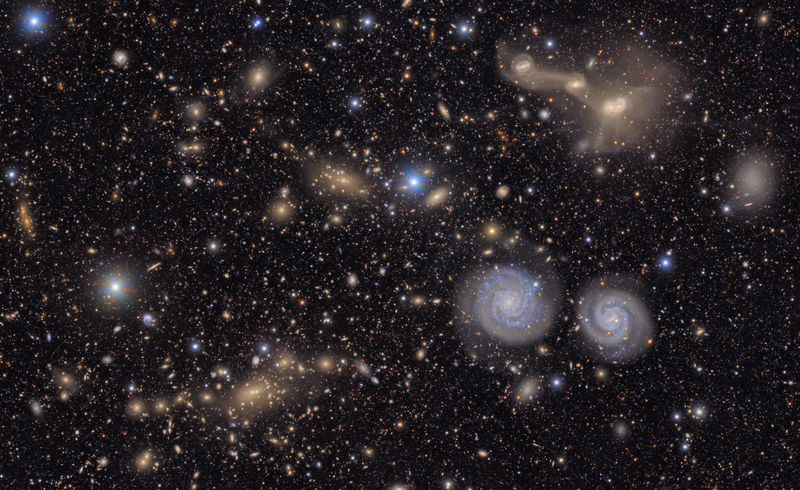
Each time a major sky survey comes online, the inevitable question arises: “Is this the end of amateur astronomy?” As the examples described here, the Vera C. Rubin Observatory is no exception. | By Brian Kloppenborg
The first images from the Vera C. Rubin Observatory announced last week marks a new era in astronomy. The unprecedented scale, cadence, and level of data access provided by Rubin and the Legacy Survey of Space and Time (LSST) program will transform how humanity studies the dynamics of the universe. The data provided by this survey will enable us to explore several of the most pressing questions from cosmology like why the universe is expanding, whether or not there have been large-scale changes in the properties of expansion over time, and the impact of dark matter on the universe.
On behalf of the AAVSO and its members, I would like to extend a heartfelt congratulations to the Vera C. Rubin Observatory team for their monumental accomplishment. We are especially grateful that the Rubin team has invested heavily in both formal and informal learning experiences through STEM and Citizen science activities. We look forward to the next several decades of discovery and collaboration.
In addition to cosmological topics, the LSST stands to usher in a new era for time-domain astronomy, including variable star research. Such topics are so central to Rubin’s mission that the Director of Rubin Construction, Dr. Željko Ivezić dedicated several minutes of the Rubin First Images press conference to the discussion of RR Lyrae variable stars. I anticipate that Rubin will uncover a vast number of new variables, reveal previously unrecognized phenomena, and enable population-level studies that astronomers have only dreamed about. For the variable star community, this is both an extraordinary opportunity and a call to action.

A New Sky Survey: Crisis or Opportunity?
Each time a major sky survey comes online, the inevitable question arises: “Is this the end of amateur astronomy?” As the examples above show, the Vera C. Rubin Observatory is no exception.
In my mind, it is certain that Rubin will transform time-domain astronomy, but I don’t regard it as a harbinger of doom. Like all instruments, Rubin has its limits. Its detectors saturate around Sloan g’ ~ 16 and LSST will image the entire southern sky once every three nights. This leaves the brighter, faster, and more frequent variable stars squarely in the hands of the amateur community.
I think there are many ways in which amateur astronomers and student researchers could produce data that is complementary to LSST. This includes:
- Monitoring bright stars that Rubin cannot measure reliability. According to VSX, there are more than 5 million known variable stars brighter than 16th magnitude. The vast preponderance of these stars have only been detected by surveys and never studied in detail.
- Capturing rapid events such as flares, eclipses, and outbursts that evolve on timescales shorter than LSST’s revisit rate. VSX has more than 3.2 million known variable stars that meet these criteria. Again, the vast preponderance of these stars have never been studied in detail.
- Providing immediate, targeted follow-up of Rubin’s alerts before professional telescopes can respond. Professional observatories are in high demand with tight schedules. It often takes days for professional astronomers to prepare a Director's Discretionary Time proposal and get it approved. Amatur astronomers are significantly more agile and can respond to alerts in minutes if they are so inclined.
- Following up on interesting transient events. Rubin is anticipated to generate over 100,000 transient event alerts each night. Similar event rates from the Zwicky Transient Facility have already demonstrated that the professional community can’t follow up on this many objects.
More importantly, while Rubin will deliver petabytes of data, vast quantities of data alone does not produce scientific insight. Discovery still depends on human curiosity, contextual understanding, and sustained engagement. These are qualities that amatuer astronomers and student researchers bring in abundance. Quite often the “hunh, that’s odd” moments of data analysis result in some of the most profound scientific discoveries.
As Rubin opens a new chapter in the story of astronomical discovery, it’s important to remember that there is ample room for meaningful contributions from amateur astronomers and student researchers. Now is the time to prepare, to collaborate, and to reaffirm the enduring value of small telescopes in astronomical research. Whether by volunteering your time, sharing your expertise, or making a financial contribution, your support is essential to ensuring that the AAVSO community thrives in this new era.

